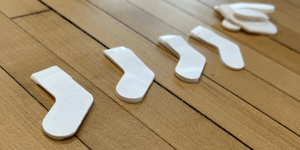Would you trust a blood pressure monitor held together by painter’s tape?
Medical device adhesives serve as bonding agents, conductors, and more. They can be lightweight and customizable, with easy applications and a range of bonding strengths. So yes, there are far more suitable options to keep your BP monitor from falling apart—but how do you find the right one?
At Strouse, we’ve spent over 38 years converting flexible materials into functional medical device components and other applications. If you’re looking for the right adhesive for your device, we can help you source it.
Finding the right adhesive depends on your intended use. Let’s discuss how different medical device adhesives are used and the most common ones so you can make an accurate choice.
How Are Adhesives Used in Medical Devices?
There are many ways to use medical device adhesives, from bonding touchscreens to affixing insulin pumps to the skin. Each application has needs based on bond strength, material properties, and longevity.
Your intended solution will largely determine the type of material you choose and your manufacturing method, so consider which type of solution you’re seeking.
a. MULTI-FUNCTIONAL BONDING SOLUTIONS
Part bonding and assembly are consistent adhesive applications when building medical devices. However, specialized materials or designs can do more than only join two substrates.
Certain materials, like tape used in diagnostics, are multifunctional. While this tape does serve as a structural adhesive, the product’s die cut features can also act as fluid channels to collect or transport the sample liquid in the device.
Another instance of multi-functional adhesive is an electrically conductive adhesive used to bond a diagnostic device to the skin while also enabling an electric signal to pass between the patient’s body and the device.
b. ADHESIVE SKIN ATTACHMENT
Attaching medical devices to the skin is a common application for remote monitoring systems and other wearable technology. The human body's surface curves, so skin tapes must be flexible and robust enough to conform well without damaging the skin's surface.
Medical device skin tapes typically use either silicone or acrylic adhesive. Silicone adhesives tend to be more gentle and easily removed, while acrylic tapes are more aggressive but longer lasting.
In addition, many (but not all) medical adhesives are compliant with ISO 10997, meaning they must be created in an ISO-certified cleanroom. ISO specifications ensure products are safely made, and ISO 10997 is particularly relevant for adhesives that come into contact with human skin.
What are the Best Adhesives for Medical Devices?
When it comes to the many medical device adhesives, you can divide them based on use cases and the types of adhesives you’ll find:
1. MULTI-FUNCTIONAL
- Conductive hydrogel
- Acrylic
- Silicone
Suppose you want to build a design with conductive properties for monitoring or other purposes. In that case, you’ll want to choose a multi-functional adhesive that can bond parts together or bond to the skin while also performing the intended function.
2. DEVICE CONSTRUCTION
- High-tack acrylic
- High-tack silicone
- Silicone rubber
- Cyanoacrylate adhesives
When you want to bond medical devices, construction adhesives can create sturdy seals between substrates (A.K.A. materials). These adhesives are stronger because they are intended to create secure, long-lasting bonds.
3. SKIN CONTACT
- Gentle acrylic
- Silicone gel
- Hydrogel
- Hydrocolloid
Skin contact adhesives must hold devices to the skin without harming or damaging it, which can be challenging when certain conditions require far gentler adhesive alternatives.
How Can I Decide Which Adhesive To Use?
Now that you’ve learned more about adhesives for medical devices, are you ready to use them in your assembly? Choosing a medical device adhesive can be challenging, which is why you should keep these questions in mind:
- What is the application?
- Where is it worn? For how long?
- What are the substrates (surfaces) you need to bond?
- What is the environment in which it will need to perform? (blood, sweat, worn in the shower, alcohol resistance, etc.)?
- Are there any adhesive chemistry requirements (no silicone, no rubber, etc.)?
When you finalize your design before you reach out, you risk trapping yourself in a complex, more expensive manufacturing process rather than a fully optimized one.
You haven't finished fully preparing your adhesive design until you’ve considered how the device component will behave during your application process.
By sourcing adhesives before consulting a converter, you risk having more expensive or less effective components. Bringing in the adhesive converting experts will ensure you know about potential material alternatives for your part component.
Request a quote if you want to pursue a project design involving medical device adhesives. We will help you build medical prototypes and determine the most efficient way of manufacturing your product.
Do you want to learn more about medical adhesives? Our Learning Center has other helpful articles and resources.
Originally published: November 2, 2023







